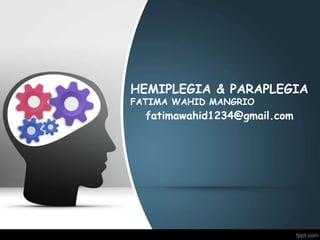Hemiplegia & paraplegia
•Descargar como PPT, PDF•
3 recomendaciones•1,507 vistas
Spinal cord injuries
Denunciar
Compartir
Denunciar
Compartir

Recomendados
Recomendados
Más contenido relacionado
La actualidad más candente
La actualidad más candente (20)
Similar a Hemiplegia & paraplegia
Similar a Hemiplegia & paraplegia (20)
Review of the Diagnosis and Treatment of Paralysis

Review of the Diagnosis and Treatment of Paralysis
Más de Fatima Mangrio
Más de Fatima Mangrio (20)
Functional organization of the cerebral cortex i sensory & motor cortex

Functional organization of the cerebral cortex i sensory & motor cortex
Coronary,Splanchnic,pulomonary, systemic & Cerebral Circulation

Coronary,Splanchnic,pulomonary, systemic & Cerebral Circulation
Mechanism of pain | Analgesic system | Pain Physiology

Mechanism of pain | Analgesic system | Pain Physiology
Último
Ultrasound color Doppler imaging has been routinely used for the diagnosis of cardiovascular diseases, enabling real-time flow visualization through the Doppler effect. Yet, its inability to provide true flow velocity vectors due to its one-dimensional detection limits its efficacy. To overcome this limitation, various VFI schemes, including multi-angle beams, speckle tracking, and transverse oscillation, have been explored, with some already available commercially. However, many of these methods still rely on autocorrelation, which poses inherent issues such as underestimation, aliasing, and the need for large ensemble sizes. Conversely, speckle-tracking-based VFI enables lateral velocity estimation but suffers from significantly lower accuracy compared to axial velocity measurements.
To address these challenges, we have presented a speckle-tracking-based VFI approach utilizing multi-angle ultrafast plane wave imaging. Our approach involves estimating axial velocity components projected onto individual steered plane waves, which are then combined to derive the velocity vector. Additionally, we've introduced a VFI visualization technique with high spatial and temporal resolutions capable of tracking flow particle trajectories.
Simulation and flow phantom experiments demonstrate that the proposed VFI method outperforms both speckle-tracking-based VFI and autocorrelation VFI counterparts by at least a factor of three. Furthermore, in vivo measurements on carotid arteries using the Prodigy ultrasound scanner demonstrate the effectiveness of our approach compared to existing methods, providing a more robust imaging tool for hemodynamic studies.
Learning objectives:
- Understand fundamental limitations of color Doppler imaging.
- Understand principles behind advanced vector flow imaging techniques.
- Familiarize with the ultrasound speckle tracking technique and its implications in flow imaging.
- Explore experiments conducted using multi-angle plane wave ultrafast imaging, specifically utilizing the pulse-sequence mode on a 128-channel ultrasound research platform. (May 9, 2024) Enhanced Ultrafast Vector Flow Imaging (VFI) Using Multi-Angle ...

(May 9, 2024) Enhanced Ultrafast Vector Flow Imaging (VFI) Using Multi-Angle ...Scintica Instrumentation
Último (20)
Climate Change Impacts on Terrestrial and Aquatic Ecosystems.pptx

Climate Change Impacts on Terrestrial and Aquatic Ecosystems.pptx
Bhiwandi Bhiwandi ❤CALL GIRL 7870993772 ❤CALL GIRLS ESCORT SERVICE In Bhiwan...

Bhiwandi Bhiwandi ❤CALL GIRL 7870993772 ❤CALL GIRLS ESCORT SERVICE In Bhiwan...
PATNA CALL GIRLS 8617370543 LOW PRICE ESCORT SERVICE

PATNA CALL GIRLS 8617370543 LOW PRICE ESCORT SERVICE
Module for Grade 9 for Asynchronous/Distance learning

Module for Grade 9 for Asynchronous/Distance learning
(May 9, 2024) Enhanced Ultrafast Vector Flow Imaging (VFI) Using Multi-Angle ...

(May 9, 2024) Enhanced Ultrafast Vector Flow Imaging (VFI) Using Multi-Angle ...
Thyroid Physiology_Dr.E. Muralinath_ Associate Professor

Thyroid Physiology_Dr.E. Muralinath_ Associate Professor
POGONATUM : morphology, anatomy, reproduction etc.

POGONATUM : morphology, anatomy, reproduction etc.
development of diagnostic enzyme assay to detect leuser virus

development of diagnostic enzyme assay to detect leuser virus
GBSN - Microbiology (Unit 3)Defense Mechanism of the body 

GBSN - Microbiology (Unit 3)Defense Mechanism of the body
The Mariana Trench remarkable geological features on Earth.pptx

The Mariana Trench remarkable geological features on Earth.pptx
Porella : features, morphology, anatomy, reproduction etc.

Porella : features, morphology, anatomy, reproduction etc.
Hemiplegia & paraplegia
- 1. HEMIPLEGIA & PARAPLEGIA FATIMA WAHID MANGRIO fatimawahid1234@gmail.com
- 2. WHAT IS PARAPLEGIA? • Paraplegia is caused by an injury of the spine at a site below the neck, below the first thoracic spinal nerve and within the sacral lumbar regions. With an injury in this region, sufferers usually lose all feeling and movement in their legs but have full control of movement in their arms.
- 3. • paraplegia refers to substantial impairment in functioning and movement, not necessarily a permanent and total paralysis. • Rarely, people with paraplegia spontaneously recover. This may be due to brain or spinal cord functions that are not yet understood, such as regeneration of neurons.
- 4. • More typically, paraplegics are able to regain some functioning with physical therapy, which works to retrain the brain and spinal cord to work around limitations while strengthening muscles and nerve connections.
- 5. What Causes Paraplegia? • Spinal cord injuries are the most common cause of paraplegia. These injuries impede the brain's ability to send and receive signals below the site of the injury.
- 6. • Some other causes include: • Spinal cord infections • Spinal cord lesions • Brain tumors • Brain infections
- 7. WHAT IS HEMIPLEGIA? • Hemiplegia (also known as hemiparalysis) is a condition caused by an injury to the brain. Like a stroke, hemiplegia only affects one side of the brain; therefore, its effects are usually down one side of the body.
- 8. • It is not always apparent that a person may have hemiplegia, as it can sometimes manifest in learning and behavioural disabilities rather than in paralysis.
- 10. CAUSES OF HEMIPLEGIA • Hemiplegia can be caused by trauma, an infection (such as meningitis or encephalitis), a systemic disorder (such as leukaemia) or hypertension (high blood pressure) in the heart. It is can also be caused during childbirth. Approximately one in 1,000 children in the UK are diagnosed with hemiplegia.
- 11. • The condition is life-long but sufferers can find better quality of life through therapy and support such as physiotherapy and occupational therapy.